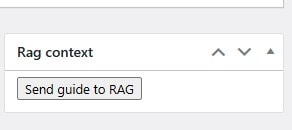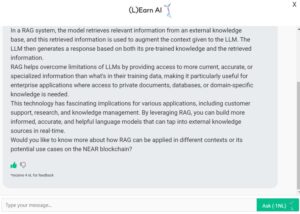What is an AI agent?
An AI agent is an autonomous software entity designed to perform tasks by perceiving its environment, processing information, and taking actions to achieve specific goals. An AI agent typically comprises three core components:
- Intelligence: The large language model (LLM) that drives the agent’s cognitive capabilities, enabling it to understand and generate human-like text. This component is usually guided by a system prompt that defines the agent’s goals and the constraints it must follow.
- Knowledge: The domain-specific expertise and data that the agent leverages to make informed decisions and take action. Agents utilize this knowledge base as context, drawing on past experiences and relevant data to guide their choices.
- Tools: A suite of specialized tools that extend the agent’s abilities, allowing it to efficiently handle a variety of tasks. These tools can include API calls, executable code, or other services that enable the agent to complete its assigned tasks.
What are the three core components of an AI agent?
What is RAG?
Retrieval-Augmented Generation (RAG) is an AI technique that enhances large language models (LLMs) by integrating relevant information from external knowledge bases. Through semantic similarity calculations, RAG retrieves document chunks from a vector database, where these documents are stored as vector representations. This process reduces the generation of factually incorrect content, significantly improving the reliability of LLM outputs.\cite{RAG}
A RAG system consists of two core components: the vector database and the retriever. The vector database holds document chunks in vector form, while the retriever calculates semantic similarity between these chunks and user queries. The more similar a chunk is to the query, the more relevant it is considered, and it is then included as context for the LLM. This setup allows RAG to dynamically update an LLM’s knowledge base without the need for retraining, effectively addressing knowledge gaps in the model’s training data.
The RAG pipeline operates by augmenting a user’s prompt with the most relevant retrieved text. The retriever fetches the necessary information from the vector database and injects it into the prompt, providing the LLM with additional context. This process not only enhances the accuracy and relevance of responses but also makes RAG a crucial technology in enabling AI agents to work with real-time data, making them more adaptable and effective in practical applications.
How does Retrieval-Augmented Generation (RAG) improve LLM responses?
What is Agent Memory?
AI agents, by default, are designed to remember only the current workflow, with their memory typically constrained by a maximum token limit. This means they can retain context temporarily within a session, but once the session ends or the token limit is reached, the context is lost. Achieving long-term memory across workflows—and sometimes even across different users or organizations—requires a more sophisticated approach. This involves explicitly committing important information to memory and retrieving it when needed.
Agent Memory with blockchain:
XTrace – A Secure AI Agent Knowledge & Memory Protocol for Collective Intelligence – will leverage blockchain as the permission and integrity layer for agent memory, ensuring that only the agent’s owner has access to stored knowledge. Blockchain is especially useful for this long persistent storage as XTrace provides commitment proof for the integrity of both the data layer and integrity of the retrieval process. The agent memory will be securely stored within XTrace’s privacy-preserving RAG framework, enabling privacy, portability and sharability. This approach provides several key use cases:
Stateful Decentralized Autonomous Agents:
- XTrace can act as a reliable data availability layer for autonomous agents operating within Trusted Execution Environments (TEEs). Even if a TEE instance goes offline or if users want to transfer knowledge acquired by the agents, they can seamlessly spawn new agents with the stored network, ensuring continuity and operational resilience.
XTrace Agent Collaborative Network:
- XTrace enables AI agents to access and inherit knowledge from other agents within the network, fostering seamless collaboration and eliminating redundant processing. This shared memory system allows agents to collectively improve decision-making and problem-solving capabilities without compromising data ownership or privacy.
XTrace Agent Sandbox Test:
- XTrace provides a secure sandbox environment for AI agent developers to safely test and deploy their agents. This sandbox acts as a honeypot to detect and mitigate prompt injection attacks before agents are deployed in real-world applications. Users can define AI guardrails within XTrace, such as restricting agents from mentioning competitor names, discussing political topics, or leaking sensitive key phrases. These guardrails can be enforced through smart contracts, allowing external parties to challenge the agents with potentially malicious prompts. If a prompt successfully bypasses the defined safeguards, the smart contract can trigger a bounty release, incentivizing adversarial testing. Unlike conventional approaches, XTrace agents retain memory of past attack attempts, enabling them to autonomously learn and adapt to new threats over time. Following the sandbox testing phase, agents carry forward a comprehensive memory of detected malicious prompts, enhancing their resilience against similar attacks in future deployments.
How to create a Personalized AI agent?
To create an AI agent with XTrace, there are three main steps to follow:
- Define the Purpose: Determine the specific tasks and goals the agent will accomplish.
- Choose the AI Model: Select a suitable LLM or other machine learning models that align with the agent’s requirements.
- Gather and Structure Knowledge: Collect domain-specific data and organize it in a way that the agent can efficiently use.
- Develop Tools and Integrations: Incorporate APIs, databases, or other services that the agent may need to interact with.
How to create a Private Personalized AI agent with XTrace?
XTrace can serve as the data connection layer between the user and the AI agents. Users will be able to securely share data from various apps into the system to create an AI agent that is aware of the user’s system. By leveraging XTrace’s encrypted storage and access control mechanisms, AI agents can be personalized without compromising user privacy. Key features include:
- Seamless Data Integration: Aggregating data from multiple sources securely.
- Granular Access Control: Ensuring only authorized AI agents can access specific data.
- Privacy-Preserving Computation: Enabling AI agents to learn from user data without exposing it.
- Automated Insights: Leveraging AI to provide personalized recommendations based on securely stored data.
- User Ownership: Empowering users with full control over their data and how it is used.
How do we use XTrace private RAG for (L)Earn AI🕺?
- We send learning materials in LLM friendly format to LNC RAG at XTrace

- Once (L)Earn AI🕺 gets the question, first it talks to private RAG and retrieve relevant information

- The LLM hosted at NEAR AI infrastructure generates a response based on both its pre-trained knowledge and the retrieved information!

- Learners are encouraged to provide feedback and get 4nLEARNs to improve (L)Earn AI🕺 to work better for NEAR community!
Updated: February 24, 2025





Top comment
The XTrace can serve as the data connection layer, facilitating communication between users and AI agents.
I'm excited to see how XTrace private RAG is being utilized to enhance the (L)Earn AI experience! The idea of sending learning materials in an LLM-friendly format to the RAG and then retrieving relevant information to inform AI responses is genius. I'm curious to know more about the type of feedback learners are encouraged to provide and how that feedback is used to improve the AI. Is there a way to track the progress and effectiveness of the 4nLEARNs system? Additionally, how does the NEAR community plan to expand the capabilities of (L)Earn AI in the future?
This explanation of how XTrace private RAG is used for (L)Earn AI is fascinating! I love how the process involves a seamless collaboration between the LNC RAG, private RAG, and the LLM hosted on NEAR AI infrastructure. The fact that learners can provide feedback and earn 4nLEARNs to improve the AI is a great incentive to encourage community engagement. I'm curious to know more about how the feedback mechanism works and how it impacts the AI's performance over time. Can anyone share more insights on this?
I'm fascinated by the concept of creating a private personalized AI agent with XTrace. The granular access control feature is a game-changer, as it addresses one of my biggest concerns about AI – privacy. I'd love to know more about how XTrace ensures that AI agents can learn from user data without exposing it. Is this achieved through homomorphic encryption or other advanced cryptographic techniques? Also, how do users have full control over their data and its usage? Can they set specific permissions or delete their data at will? Looking forward to learning more about XTrace's innovative approach to AI personalization!
Fascinating to see how XTrace private RAG is leveraged for (L)Earn AI! I'm curious to know more about the LLM friendly format required for the learning materials – is it a standardized template or does it vary depending on the type of content? Also, how does the feedback mechanism work in terms of learners providing 4nLEARNs to improve (L)Earn AI? Is there a leaderboard or some kind of incentives to encourage users to contribute to the AI's growth? Excited to see how this technology can enhance learning experiences for the NEAR community!
Fascinating insight into the limitations of AI agents! I never realized that their memory was so ephemeral. It makes sense, though, given the constraints of token limits. The idea of explicitly committing important info to memory raises questions about how we define what's 'important' and how we ensure that agents don't get bogged down by unnecessary data. Are we looking at a future where AI agents have their own 'note-taking' systems? How would that impact their ability to learn and adapt? Looking forward to seeing how this tech evolves!
Fascinating insight into the limitations of current AI agents! I never realized that their memory was restricted to a maximum token limit, making it impossible for them to retain context beyond a single session. This raises important questions about the scalability and reliability of AI systems in real-world applications. For instance, how can we trust AI assistants to provide accurate support if they can't recall crucial information from previous interactions? The concept of 'committing important information to memory' opens up new avenues for research, and I'd love to see more exploration into how to develop more human-like memory capabilities in AI agents.
Fascinating breakdown of the architecture behind AI agents! I'm intrigued by the interplay between the intelligence, knowledge, and tools components. It raises questions about the role of human oversight in shaping the agent's goals and constraints. How do we ensure that the system prompt guiding the intelligence component aligns with human values and ethics? Moreover, as AI agents become more sophisticated, how will we balance the need for autonomy with the requirement for transparency and accountability? Looking forward to exploring these implications further!
This explanation of AI agents has really helped me understand the intricacies of their functioning. I'm curious, though – how do these agents balance their reliance on domain-specific knowledge with the need to adapt to novel situations? Do they have a mechanism to update their knowledge base as they encounter new information, or are they limited by their initial programming? Additionally, what measures are in place to ensure that these agents' goals and constraints are aligned with human values and ethics? The potential for autonomous decision-making is both exciting and unsettling, and I'd love to hear more about the safeguards in place.
Fascinating! Creating a personalized AI agent with XTrace seems like a game-changer. I'm curious, though – how do you ensure that the chosen AI model doesn't perpetuate biases or limitations present in the training data? Additionally, what kind of domain-specific data is necessary to structure the knowledge effectively? Can you provide some examples of successful AI agents built using this approach? Understanding the potential pitfalls and success stories would help me better understand the feasibility of this approach for my own projects.
Fascinating breakdown of the AI agent's components! I'm struck by how the 'Knowledge' component seems to be the key differentiator between a basic chatbot and a truly autonomous AI agent. It's not just about understanding language, but about having a rich context to draw from. This makes me wonder: how do we ensure that the knowledge base is diverse, accurate, and unbiased? Is it possible to have an AI agent that's not only intelligent but also empathetic and culturally aware? The possibilities are endless, but so are the potential pitfalls. I'd love to hear more about how these agents are being designed with ethical considerations in mind.
Wow, the concept of creating a private personalized AI agent with XTrace is truly revolutionary! I love how it prioritizes user privacy while still allowing for seamless data integration and granular access control. The idea of having full ownership over my data and how it's used is incredibly empowering. I do have a question, though – how will XTrace ensure that the AI agents are transparent and explainable in their decision-making processes? Transparency is key to building trust in AI, and I'd love to hear more about how XTrace addresses this aspect. Overall, this technology has the potential to transform the way we interact with AI and I'm excited to see its development!
I think the concept of agent memory is often overlooked in AI development, but it's crucial for creating truly intelligent systems. The limitation of token limits and session-based memory is a major hurdle in achieving continuity and consistency in AI interactions. I'm curious to know more about the 'sophisticated approach' mentioned in the article – what kind of architectures or algorithms are being used to enable long-term memory in AI agents? Are there any successful implementations or case studies that showcase the benefits of agent memory in real-world applications?